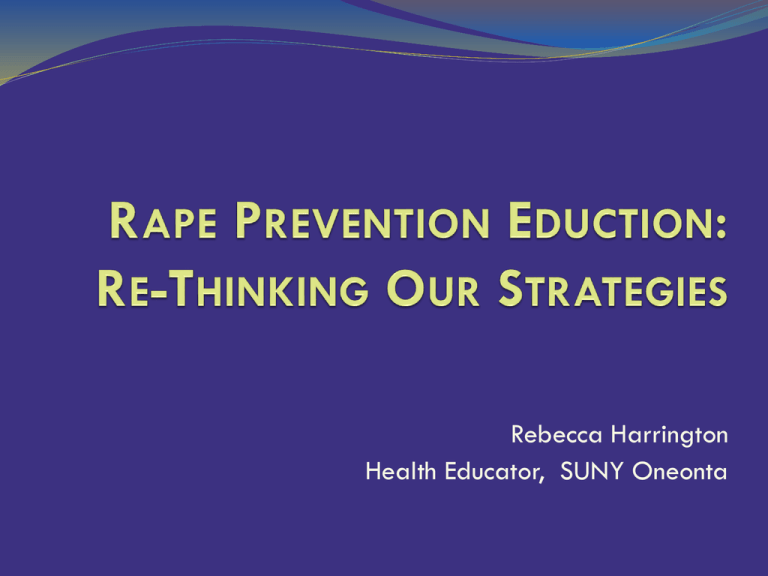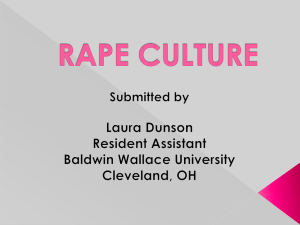
Rebecca Harrington
Health Educator, SUNY Oneonta
Learning Objectives
The attendee should be able to:
Explain the steps in creating an educational video
Describe how research in other fields is relevant to sexual
assault prevention.
Review the student learning outcomes of a web-based
educational intervention
Discuss ways this campaign could be adapted for other
colleges & universities
First things first, let’s watch the video.
Creating the Re-Think Campaign
Fall 2010-educational needs of the campaign
Spring 2011-writing & filming video, submitting IRB,
getting t-shirts
Fall 2011-editing film, tweaking distribution plan,
communication with potential supporters
Spring 2012-launching of campaign
Summer 2012-rewrite pre & post test, resubmit IRB
2012-2013-launch II
What did we want to do?
Goals of the program:
Address rape culture
Address victim blame vs. perpetrator blame
While keeping in mind:
Busy schedules of students
Previous experience with mandated student programs
A need to make materials as inclusive as possible
No assumptions of gender or sexual orientation of either victim or
perpetrator
Where were we coming from
Previous speakers on campus
David Lisak, Spring 2009
Victoria Banyard, Spring 2010
Prior to Spring 2009
Doing the standard prevention programming
Hired speakers at costs of $3500+
Utilized available poster campaigns $500+
Plan A: Make a t-shirt
Our Alcohol & Other Drug Committee made one t-shirt a
semester with alcohol education messages done in fun
ways.
So we brainstormed & designed our t-shirt
Messages we addressed
Don’t get drunk
Don’t walk alone
Watch what you wear
They kissed
They knew each other
They had sex before
(basically our list of the most commonly heard victim-blaming
messages rephrased to remove gender and sexual
orientation information)
Front of T-shirt
Back of
T-shirt
How were we going to distribute?
Couldn’t just give these to students without some minimal
amount of education.
How were we going to get students into workshops with
only the lure of a t-shirt?
The solution?
Make a video!
Why a video?
There is only one “me” on my campus and sexual assault
prevention is just one hat I wear. The amount of time to
provide multiple workshops was a barrier.
Film it once. Get a few year’s use. Students can view at a
time most convenient for them.
The ability to share with others.
Another influence: FCK8 videos
Writing the Script
And Re-Writing the Script
And Re-Writing the Script
The first script: More than 20 minutes long. It would make for a great
program and perhaps some day it will be. Never even filmed
The second script: Still more than 15 minutes long. Told to axe it some more.
The third script: Close to 10 minutes long. We proceed to filming.
Working with our production team
Using campus TV studio
We are fortunate to have a mass communications major & a
real TV studio.
We were able to access these resources for free.
It was easy to schedule our “talent” as the studio is centrally
located on campus.
Gained the expertise of people who know how to do this
stuff
Filming
Chose to use a variety of faculty & students. Goal of a
diverse set of people spreading the message. Ended up
with 10 different people in front of the camera.
And Re-Filming
• Our TV director decided to reshoot the whole thing
in HD.
Things I learned while making this video:
1. If you can express it visually, do so.
2. Shorter is better.
3. Being a good presenter is one thing, being an
educational video writer is slightly different.
4. Listen to the TV expert.
5. How to operate a teleprompter machine.
6. My forehead tends to wrinkle when I read a
teleprompter.
The Editing Process
Round 1:
Each line read by multiple people
Hours of video watching to make final assignments
Make a rough cut video
Round 2:
Each line read multiple times by one person
Hours of video watching to choose final cuts
Round 3:
Cut & edit while asking: what’s the educational goal? Does a
line support this? If yes, keep; If no, discard.
How to Edit for the Visual Learner
Does the text support the final learning
goal?
Yes
If it can’t be
done visually
keep it
If it can be
done visually
make it visual.
No
Discard
Going online
www.oneonta.edu/development/wellness/rethink2.asp
We weighed several options for how to move people
through a pre test, video watch, post test.
We chose the lower tech route:
People sent to our webpage (created a “keymatch”)
Had to read a paragraph of instruction (barrier for some)
Link to pre test, video link provided at end.
Post test link on main page.
The Bottom Line –Our Costs
500 shirts
Keytags
Printing Costs (on-campus printer)
$2251.25
$170.00
$20.00
TOTAL
$2441.25
The Bottom Line –FREE/donations
Group
Creative Media Services
Greek Life
Athletics
Women’s Studies
Technology Services
Office of Assessment
Provided
Video & Editing
60% mandatory prog.
$100 party
Focus group time
Survey software
Survey design support
Sexual Assault Prevention
From the world of sexual assault prevention:
David Lisak, PhD (The Undetected Rapist)
Victoria Banyard, PhD (Bringing in the Bystander)
Mary Koss, PhD (roots of research)
Linda Langford, PhD (campus violence prevention expert)
Sexual Assault Prevention, cont.
McMahon, Sarah. (2011). Changing perceptions of Sexual
Violence Over Time. Harrisburg, PA: VAWnet, a project of the
National Resource Center on Domestic Violence. Available at
www.vawnet.org
“more work is needed to shift peoples’ attitudes toward
supporting victims and holding perpetrators accountable.”
“the way the public perceives the causes of sexual
violence…their ideas about victims and perpetrators appear
to be lagging behind those of advocates & experts in the
field.”
“change perceptions about what attitudes and behaviors are
approved and desirable within their community.”
Educational Research
Ineffectiveness of lectures
One time events have a “bubble effect”
We have a generation of students who learn fluently in
media based learning.
Need more reasons to dump the lecture?
From “10 Reasons to Dump Lectures”
1. An hour format has nothing to do with the psychology of
2.
3.
4.
5.
learning, it’s just convenient.
Lectures allow for passive learning, you need
participation if you want learning.
Our ability to retain information drops off after 10-20
minutes.
Cognitive overload (KISS strategy)
Trapped by place & time
Psychology
Stages of Change
In group/out group
The
pyramid
of hate
(Anti-Defamation
League)
Marketing Research
ROI “Return on Investment”
CPI “Cost per impression”
Survey of businesspeople how they use promotion products.
Avg promo product is kept 5.4 months
Shirts 344 impressions/month
Psychology & Marketing
Implicit theory of self
Entity Theorists –more likely to believe in fixed traits
Incremental Theorists- more likely to believe in malleable
traits
How this applies to branding
The Victoria Secrets study.
Entity theorists….need “brand personalities” to fix flaws
Incremental theorists…more likely to not care so much about
brand.
“Individuals who endorse entity theory view their personal
qualities as something they cannot improve through their own
direct efforts; instead, they seek out opportunities (such as
brand experiences) to signal their positive qualities to the self
or others. Conversely, individuals who endorse incremental
theory view their personal qualities as something they can
enhance through their own efforts at self‐improvement,
reducing the value of signaling opportunities through brands.”
So applying that back to SA prevention…
Whether we like it or not our prevention efforts are seen as
“brands.”
http://www.youtube.com/watch?v=9DWLyrljLDk&feature=related
It was time for us to re-brand. So our campaign mimics things
our students would experience in other branding campaigns.
Video, shirts, lots of people wearing them on campus.
Something that looks like a logo, consistent colors, etc.
Marketing
Exposure
We learn to ignore…catch with guard down
Texting/clown on unicycle study
http://www.youtube.com/watch?v=Ahg6qcgoay4
Subliminal Perception
Exposure effect
Subliminal presentation
Conformity (Social Norms)
Uggs vs flip flops
Neuropsychology of Marketing
Neural Focus Groups
“…the study suggests that the neurological reactions of a few
– reactions that people are not even consciously aware of, and
that differ from the opinions they express – can predict the
responses of many other people to ad campaigns promoting
specific behaviors.”
[for the brain science geeks in the audience: they looked at the medial
pre-frontal cortex via fMRI. This part of the brain was found in earlier
studies to be linked to positive responses to persuasive messages]
Other tidbits
Simple font choice=easy to do
Charts, Graphs & Numbers, Oh My!
How we did on numbers
Part 1 (pre test, video, post test)
n=476
n=327
How many people got the shirt
(we’ve cont. to give out shirts/421 shirts distr. total))
Survey 3 (shirt day follow up)
n=147
Survey 4 (two weeks post)
Completed all 4 surveys
n=125
n=79
How we got those people
Greek Life (60% mandatory)
Athletics (team with highest participation rewarded)
Residence Life
GEARS/Women’s Studies
Professors
Campus newsletter
Direct appeals
“traditional” program advertisement methods
Thinking about the crimes of sexual assault & rape, what percentage of
the responsibility is with: the victim; the perpetrator (sum must equal
100).
How likely is it that you will talk with following groups of
people about sexual assault and rape?
Have you already talked about sexual assault with?
Closest circle of friends
47.6
Other friends
13.6
Acquaintances
5.0
Family
21.5
Professors
7.5
Co-workers
4.7
Others
3.4
How likely is it that you will talk with the following groups
of people about sexual assault?
Prior knowledge (pre-test only)
Please list rape prevention messages you have been taught
previously.
77% of participants listed at least one of the messages we
addressed in the video.
Most common:
Don’t walk alone
Watch what you wear
Don’t get drunk/watch what you drink
Another frequently recalled message was “no means no”
Prior knowledge
Do you know any rape/sexual assault myths?
Trends:
“she asked for it”/victim responsibility
It’s not victims fault
Stranger rape
All perps are males/all victims are females
How interested are you in helping educate your peers
about the crimes of sexual assault and rape?
My choice of words and behaviors can have an impact on sexual
assault on my campus.
Additional Post-Test Questions
Did you learn a lot of new information about sexual assault
& rape from the video?
34%- I learned a lot of new information
56%- I learned a little new information
10%- I knew all of this information before
Would you recommend this video to a friend?
95% Yes
What did you find most interesting?
98
71
59
48
39
20
11
The new messages vs. the old
You can be raped by someone you know
That victims blame themselves/victim blaming
That 1 in 4 have been victims
Rapists on average have 14 victims
Need to get consent every time
You can be raped in a relationship incl. marriage
What is the acquaintance rape myth?
87
86
80
80
55
“drank too much”
nice guy
miscommunication
won’t happen again
wasn’t premeditated
110 comments addressed a point from the video but didn’t
answer the question directly.
Can you list a characteristic of an undetected
rapist?
67% could list at least one characteristic
30% could list two or more
93 Good looking
77 Prey on Drunk women
74 Charismatic
57 Ply them with Alcohol
52 Don’t Use Weapons
45 Not Mentally Ill
41 Don’t Think What They’re Doing is Wrong
38 All ethnicities
18 Plan & Premeditate
9 Access to Consensual Sex
As a result of watching this video, I will…
I will see any rape situation differently now
Be aware of what the woman I am with is consenting to
participate in
Think again about how rape is portrayed in movies and TV shows
Be more aware of how the use of words will impact blame.
Still not rape girls because it is still a crime and still really scummy
Not feel bad about what I’ve actually went through
Honestly, I probably won’t do too much, but I am definitely more
aware.
T-shirt Wearing Follow Up
T-shirt Wearing Follow Up
Did you wear your shirt on assigned day
99% of respondents had
N=150 (less than half of the people who received shirts)
How many conversations did you have during the time you
wore your shirt? Average=4.7
Did wearing the shirt make you feel like you had a positive
effect on the SUNY Oneonta community?
87% Yes
Do you think you will wear this shirt again? 95% Yes
T-shirt Stories
My friend just said to me, that its great i was supporting such an event that doesn't
really get much attention until something bad happens.
My education professor had me stand up in front of the class and explain what the
meaning was. My class was very interested in hearing all about it and getting
involved.
A lot of people were inquiring about the shirts and wanted to know how to get
involved in the cause.
Woman in mills asked what it meant and I explained how we are trying to change
people's perception of rape and who is really to blame and she was very happy that
people were beginning to vocalize things like that.
A lot of people were curious as to why I was wearing the t-shirt, and with that I
explained to them that we are trying to redefine the concepts of rape and the
reasoning behind the way people think of rape.
Two week follow up
Timeline recap:
Mid-February Rethink project goes live
March 19-23 Spring break
April 2-6 Shirt wearing/tabling
April 17-Take Back the Night
April 22-Final post video follow up
Do you receive a shirt?
Yes and I wore it on assigned day
Yes, but I didn’t wear it assigned day
No, never picked it up 11%
No, didn’t want one
2%
79%
11%
How many times have you worn your shirt?
2.29
Thinking about the number of times you saw others
wearing the Re-think shirt, did you see…
A lot of people wearing the shirt
Some people wearing the shirt
A few people wearing the shirt
Hardly anyone wearing the shirt
No one wearing the shirt
23%
49%
23%
7%
4%
Blame shifting
How likely is it that you will talk with following groups of
people about sexual assault and rape?
Have you already talked about sexual assault with?
Closest circle of friends
47.6
Other friends
13.6
Acquaintances
5.0
Family
21.5
Professors
7.5
Co-workers
4.7
Others
3.4
67.7
30.7
9.7
28.2
15.3
13.0
10.7
How likely is it that you will talk to the following
people…(neutral+somewhat unlikely+very unlikely)
Learning retention
What is the acquaintance rape myth?
1 person could recall
The majority replied with a response that was related either
to something they knew about the definition of
“acquaintance rape” or a “rape myth”
Can you list a characteristic of an “undetected rapist”?
47% could
Responding
Pick one of the statements below, if you heard one, how
might you respond? (he/she was drinking; was dressed
inappropriately, were seen kissing, had sex before.
77.9% repeated something from the video
19.5% re-worded/rephrased in a meaningful way
Examples:
Seen kissing? It doesn’t mean they both wanted to have sex! Big jump to
make, don’t ya think!
People have the right to wear whatever they want to and feel comfortable
within their own skin. They shouldn't have to watch what they wear because
of fear of being raped.
He shouldn't drink so much that he cannot control his behavior
F**k off, that’s no excuse, its still rape
At first I thought they could be used as partial excuses but from this research
project I've learned that they are not excuses and that I am actually a victim.
You might feel they dressed inappropriately, but to them, they feel like they
dressed in a way that makes them feel comfortable and sexy. They dressed
that way because it makes them feel good about themselves and feeling
good about oneself is not them asking to get raped.
When they participated
Other Feedback
Criminal Justice Club
Counselors
Faculty & Staff
How This Model Could be Adapted for You
What’s Your Philosophy?
Beyond mission & vision….what do you really feel in your
head, heart & gut?
http://www.oneonta.edu/development/wellness/videos/pyramid.wmv
Your Theory/Philosophy of Learning
From my coursework in education this is what I’ve boiled it
down to:
Spiral theory of learning (Jerome Bruner)- The Process of
Education (1960) revealed his particular view of
constructivism - the theory that learners actively construct
their own knowledge based upon the things they know now
and have known in the past.
Needed to learn the fundamental principles of subjects
rather than just master facts.
“What one thing do I really want them to take away?”
This might not be a fact, a feeling can be just as powerful
Taking Two Steps Back
This video (and many of prevention efforts) are a few
steps back from the issue at hand.
This brings the issue back to the place where we all hold
some responsibility.
Removes the barrier of denial.
After You’ve Got All That
Video
Print Media
Web
T-Shirts
Video
First, I will happily send the final script to anyone who
wants it.
Get your ideas on paper.
My process…one Saturday afternoon…
Find the video people…most campuses have them
Biggest difference is time
Media
Developing a message
Developing graphics that support your message
Everything counts
Black & White….because rape is a black and white
issue…there is no grey. It’s stark, it’s serious.
Handwritten responses, multiple writers.
It’s more personal, shows multiple voices.
What works for your campus/situation?
Print media is cheap for us (on-campus printer)
T-shirts, we have a positive history with this
We had good working relationships with:
Constituencies (Greek life, athletics, res life)
Professors
Students
Where we’re going next
The biggest change was re-vamping pre & post test.
Dropping questions that didn’t yield good data
Retention of undetected rapist knowledge
Adding questions that can help us dig a bit deeper
Stages of change related to sexual violence
V. Banyard had already developed a tool that we could use.
Distribution
Working with faculty who teach related coursework
Identifying days of shirt wearing (mimics other campaign on
campus)
Stages of Change/Bystander Willingness Sexual Violence
Bringing in the Bystander (Banyard)
I don’t think sexual assault is a big problem on campus.
I don’t think there is much I can do about sexual assault on campus.
There isn’t much need for me to think about sexual assault on campus, that’s
the job of someone else.
Sometimes I think I should learn more about sexual assault but I haven’t done
so yet.
I think I can do something about sexual assault and am planning to find out
what I can do about the problem
I am planning to learn more about the problem of sexual assault on campus.
I have recently attended a program about sexual assault.
I am actively involved in projects to deal with sexual assault on campus.
I have recently taken part in activities or volunteered my time on projects
focused on ending sexual assault on campus.
Questions?
Contact Information:
Rebecca.Harrington@oneonta.edu
SUNY Oneonta, CHW Center
Oneonta, NY 13820
(607) 436-3540






